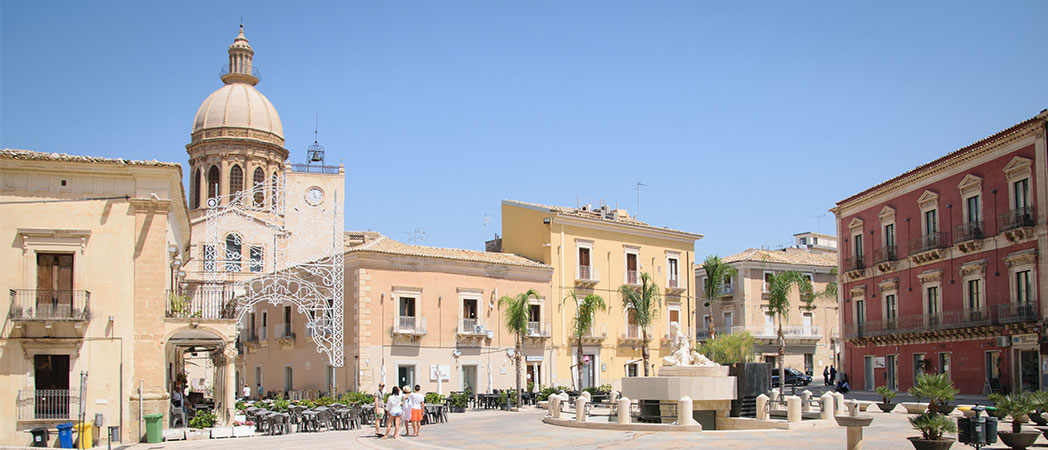
"Città Teatro" is how the writer Gesualdo Bufalino defined Comiso, a small town in the province of Ragusa, in light of its geographical position and the many picturesque corners hidden in its historic centre.
The town is located in the shadow of the Iblei Mountains and has a past as a Roman spa centre, in the light of the discoveries made during the construction of the Town Hall, with the remains of the tepidarium, the calidarium and frigidarium, dating back to the II AD.
Throughout its history, Comiso has been dominated by the Byzantines, Arabs, Normans and Aragonese and this has made the historical and artistic heritage of Comiso worthy of being discovered during a trip to Sicily.
Comiso: what to see
Source Diana square it is the heart of the village of Comiso and takes its name from the statue of the deity that decorates the fountain here: legend has it that Diana loved to bathe in the spring that flowed right where the square stands today. It is here that the Town Hall stands, built in 1887 in the Umbertino style with classical decorations such as the monumental staircase, the Corinthian and Doric capitals.
Among the oldest civil buildings in Comiso is the Old Fish Market, now home to the "Natural History Museum", including sections on zoology and paleontology, with remains of specimens of elephants, cetaceans, deer, bison, hippopotamuses, deep-sea fish and tropical insects.
Well worth a visit then Hake Theater, which takes its name from the noble family that in the past made Comiso a rich and developed community. It is a small but very elegant theater, in its neoclassical style with lots of pediments and pillars in white local stone: even Arnoldo Foà performed in the Naselli Theater.
Walking through the alleys of the village, you will come across many places where you can taste the traditional cuisine of the place, an unmissable opportunity to recharge your batteries before returning to the discovery of Comiso. Absolutely to taste the sweet couscous, the swordfish rolls, the aubergine caponata and the bucellato. It is a donut made of shortcrust pastry, filled with orange peel, raisins and dried figs. The best pairing for bucellato is with a glass of Ambrato di Comiso wine, an excellent white wine perfect for desserts.
Among the most iconic monuments of Comiso is the Peace Pagoda: it is a building whose construction was commissioned by the Buddhist monk Morishita and has a dome with a pinnacle on top. Here the Peace Festival takes place in July and the Flower Festival in April, two very heartfelt events in Comiso together with Easter "At Paci", during which the reunification between the risen Christ and the Madonna is staged in a truly suggestive way.
The churches of Comiso
Comiso is a village full of beautiful churches, including the Baroque one Mother Church restored after the earthquake of 1693 and the Church of the Annunciation, built on the remains of the Romanesque-Byzantine church of San Nicola: of the latter you can appreciate the beautiful wooden ceiling embellished with images of the life of San Filippo Neri.
La Church of S. Maria delle Stelle it dates back to the 700th century, although it was later restored in the 800th century after the earthquake: one can appreciate the late Baroque façade by Gagliardi, the late XNUMXth century neo-Gothic dome and the belfry with a small dome. The church is located in the Piazza delle Erbe next door at the Old Market from 1871, connected to it by a beautiful staircase: the Old Market, which today is the headquarters of the Gesualdo Bufalino Foundation, has an external and internal loggia that surrounds an elegant fountain.
They deserve to be visited Church of the Santissima Annunziata, of which you can appreciate a beautiful wooden ceiling decorated with scenes from the life of San Filippo Neri and the very ancient Sanctuary of San Francesco, with its beautiful 400th century cloister.
In front of the Hake Castle of sixteenth-century origin finally rises the Church of St. Blaise: despite its origins dating back to the 500th century, when it was built on the remains of a place of worship from the 700rd-XNUMXth century, it was rebuilt in the XNUMXth century. It has a sober facade, flanked by a bell tower decorated with colorful majolica: the church preserves a seventeenth-century simulacrum of San Biagio which, in the month of July, is carried in procession on the occasion of the patron saint's day. There Feast of San Biagio in Comiso it is also celebrated in January, to thank him for having saved the citizens from the earthquake of 1693 and in February, an occasion for the faithful to receive the blessing of the gorges.
If you want to discover a quiet corner of Sicily and you love places full of history and art, then reach Comiso and let yourself be carried away among its architectural beauties and its food and wine.
© Image by Antonio Pignato, CC BY-SA 4.0, via Wikimedia Commons









